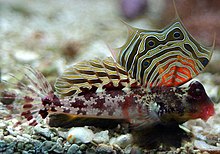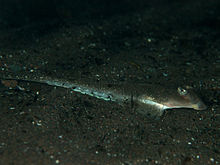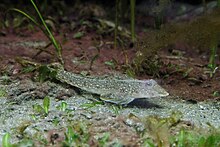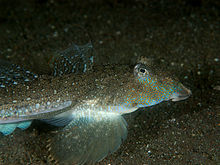Lyrefish
| Lyrefish | ||||||||||||
|---|---|---|---|---|---|---|---|---|---|---|---|---|

Striped lyrefish ( Callionymus lyra ) |
||||||||||||
| Systematics | ||||||||||||
|
||||||||||||
| Scientific name | ||||||||||||
| Callionymidae | ||||||||||||
| Bonaparte , 1832 |
The family of the lyre fish (Callionymidae) is a group of the perch relatives (Percomorphaceae). There are 20 genera and over 190 species .
distribution
Almost all of them are bottom-dwelling fish of the tropical Indo-Pacific . In the Mediterranean seven species of live Callionymus . Lyrefish live on sandy bottoms and reefs.
Appearance
Lyrefishes are small, elongated, scaleless bottom fish. They have two dorsal fins , the first has one to four hard rays (it is completely absent in two species). There is a sexual dimorphism in many species ; Males usually have a larger and more colorful first dorsal fin. The pelvic fins are very large and widely spaced. Lionfish use their ventral fins as supports when resting on the bottom. The head is large, triangular when viewed from above, the mouth small and pointed. The eyes are up. The front gill cover has a strong thorn, which can be studded with barbs, the gill cover is thornless. The gill opening is only small and lies on the top of the head. The lateral line organ is complete. Lyrefish are two to 30 centimeters long, depending on the species. Many lyre fish are very colorful.
Fin formula : dorsal 0-IV / 5-11, anal 4-10
Genera and species
- Genus Anaora Gray, 1835
- Anaora tentaculata Gray, 1835
- Genus Bathycallionymus Nakabo, 1982
- Bathycallionymus kaianus (Günther, 1880)
- Bathycallionymus sokonumeri (Kamohara, 1936)
- Genus Callionymus Linnaeus, 1758
- Callionymus aagilis Fricke, 1999
- Callionymus acutirostris Fricke, 1981
- Callionymus afilum Fricke, 2000
- Callionymus africanus (Kotthaus, 1977)
- Callionymus alisae Fricke, 2016
- Callionymus altipinnis Fricke, 1981
- Callionymus amboina Suwardji, 1965
- Callionymus annulatus Weber, 1913
- Callionymus australis Fricke, 1983
- Callionymus belcheri Richardson, 1844
- Callionymus beniteguri Jordan & Snyder, 1900
- Callionymus bentuviai Fricke, 1981
- Callionymus bifilum Fricke, 2000
- Callionymus bleekeri Fricke, 1983
- Callionymus boucheti Fricke, 2017
- Callionymus carebares Alcock, 1890
- Callionymus colini Fricke, 1993
- Callionymus comptus Randall, 1999
- Callionymus cooperi Regan, 1908
- Callionymus corallinus Gilbert, 1905
- Callionymus curvicornis Valenciennes, 1837
- Callionymus decoratus (Gilbert, 1905)
- Callionymus delicatulus Smith, 1963
- Callionymus doryssus Jordan & Fowler, 1903
- Callionymus draconis Nakabo, 1977
- Callionymus enneactis Bleeker, 1879
- Callionymus erythraeus Ninni, 1934
- Callionymus fasciatus Valenciennes, 1837
- Callionymus filamentosus Valenciennes, 1837
- Callionymus flavus Fricke, 1983
- Callionymus fluviatilis Day, 1876
- Callionymus formosanus Fricke, 1981
- Callionymus futuna Fricke, 1998
- Callionymus gardineri Regan, 1908
- Callionymus goodladi (Whitley, 1944)
- Callionymus grossi Ogilby, 1910
- Callionymus guentheri Fricke, 1981
- Callionymus hainanensis Li, 1966
- Callionymus hildae Fricke, 1981
- Callionymus hindsii Richardson, 1844
- Callionymus huguenini Bleeker, 1858
- Callionymus io Fricke, 1983
- Callionymus izuensis Fricke & Zaiser Brownell, 1993
- Callionymus japonicus Houttuyn, 1782
- Callionymus kailolae Fricke, 2000
- Callionymus keeleyi Fowler, 1941
- Callionymus koreanus (Nakabo, Jeon & Li, 1987)
- Callionymus kotthausi Fricke, 1981
- Callionymus leucobranchialis Fowler, 1941
- Callionymus leucopoecilus Fricke & Lee, 1993
- Callionymus limiceps Ogilby, 1908
- Callionymus luridus Fricke, 1981
- Striped lyrefish ( Callionymus lyra ) Linnaeus, 1758
- Callionymus macclesfieldensis Fricke, 1983
- Callionymus macdonaldi Ogilby, 1911
- Spotted lyrefish ( Callionymus maculatus ) Rafinesque, 1810
- Callionymus madangensis Fricke, 2014
- Callionymus margaretae Regan, 1905
- Callionymus marleyi Regan, 1919
- Callionymus marquesensis Fricke, 1989
- Callionymus martinae Fricke, 1981
- Callionymus mascarenus Fricke, 1983
- Callionymus megastomus Fricke, 1982
- Callionymus melanotopterus Bleeker, 1851
- Callionymus meridionalis Suwardji, 1965
- Callionymus moretonensis Johnson, 1971
- Callionymus mortenseni Suwardji, 1965
- Callionymus muscatensis Regan, 1905
- Callionymus neptunius (Seale, 1910)
- Callionymus obscurus Fricke, 1989
- Callionymus ochiaii Fricke, 1981
- Callionymus octostigmatus Fricke, 1981
- Callionymus ogilbyi Fricke, 2002
- Callionymus omanensis Fricke et al., 2014
- Callionymus oxycephalus Fricke, 1980
- Callionymus persicus Regan, 1905
- Callionymus petersi Fricke, 2016
- Callionymus planus Ochiai, 1955
- Callionymus platycephalus Fricke, 1983
- Callionymus pleurostictus Fricke, 1982
- Callionymus profundus Fricke & Golani, 2013
- Callionymus pusillus Delaroche, 1809
- Callionymus regani Nakabo, 1979
- Ornamental lyrefish ( Callionymus reticulatus ) Valenciennes, 1837
- Callionymus richardsonii (Bleeker, 1854)
- Callionymus risso Lesueur, 1814
- Callionymus rivatoni Fricke, 1993
- Callionymus russelli Johnson, 1976
- Callionymus sagitta Pallas, 1770
- Callionymus sanctaehelenae Fricke, 1983
- Callionymus scaber McCulloch, 1926
- Callionymus scabriceps Fowler, 1941
- Callionymus schaapii Bleeker, 1852
- Callionymus semeiophor Fricke, 1983
- Callionymus sereti Fricke, 1998
- Callionymus simplicicornis Valenciennes, 1837
- Callionymus sphinx Fricke & Heckele, 1984
- Callionymus spiniceps Regan, 1908
- Callionymus stigmatopareius Fricke, 1981
- Callionymus sublaevis McCulloch, 1926
- Callionymus superbus Fricke, 1983
- Callionymus tenuis Fricke, 1981
- Callionymus tethys Fricke, 1993
- Callionymus umbrithorax Fowler, 1941
- Callionymus valenciennei Temminck & Schlegel, 1845
- Callionymus variegatus Temminck & Schlegel, 1845
- Callionymus virgis Jordan & Fowler, 1903
- Callionymus whiteheadi Fricke, 1981
- Callionymus zythros Fricke,
- Genus Calliurichthys
- Calliurichthys izuensis Fricke & Zaiser Brownell, 1993
- Calliurichthys scaber McCulloch, 1926
- Genus Dactylopus Gill, 1859
- Dactylopus dactylopus (Valenciennes, 1837)
- Dactylopus kuiteri Fricke, 1992
- Genus Diplogrammus Gill, 1865
- Diplogrammus goramensis Bleeker, 1858
- Diplogrammus gruveli Smith, 1963
- Diplogrammus infulatus Smith, 1963
- Diplogrammus pauciradiatus (Gill, 1865)
- Diplogrammus paucispinis Fricke et al., 2014
- Diplogrammus pygmaeus Fricke, 1981
- Diplogrammus randalli Fricke, 1983
- Diplogrammus xenicus (Jordan & Thompson, 1914)
- Genus Draculo Snyder, 1911
- Draculo celetus (Smith, 1963)
- Draculo maugei (Smith, 1966)
- Draculo pogognathus (Gosline, 1959)
- Draculo shango (Davis & Robins, 1966)
- Genus Eleutherochir Bleeker, 1879
- Eleutherochir mirabilis (Snyder, 1911)
- Eleutherochir opercularis (Valenciennes, 1837)
- Genus Eocallionymus Nakabo, 1982
- Eocallionymus papilio (Günther, 1864)
- Genus Foetorepus Whitley, 1931
- Foetorepus agassizii (Goode & Bean, 1888)
- Foetorepus australis Nakabo & McKay, 1989
- Foetorepus calauropomus (Richardson, 1844)
- Foetorepus dagmarae (Fricke, 1985)
- Foetorepus delandi Fowler, 1943
- Foetorepus garthi (Seale, 1940)
- Foetorepus goodenbeani Nakabo & Hartel, 1999
- Foetorepus kamoharai Nakabo, 1983
- Foetorepus kanmuensis Nakabo, Yamamoto & Chen, 1983
- Foetorepus kinmeiensis Nakabo, Yamamoto & Chen, 1983
- Foetorepus masudai Nakabo, 1987
- Foetorepus paxtoni (Fricke, 2000)
- Foetorepus phasis (Günther, 1880)
- Foetorepus talarae (Hildebrand & Barton, 1949)
- Foetorepus valdiviae (Trunov, 1981)
- Genus Neosynchiropus
 Eye spot lyrefish ( Neosynchiropus ocellatus )
Eye spot lyrefish ( Neosynchiropus ocellatus )- Neosynchiropus ijimae (Jordan & Thompson, 1914)
- Eye spot lyrefish ( Neosynchiropus ocellatus (Pallas, 1770))
- Genus Orbonymus Whitley, 1947
- Orbonymus rameus (McCulloch, 1926)
- Genus Paracallionymus Barnard, 1927
- Paracallionymus costatus (Boulenger, 1898)
- Genus Paradiplogrammus Nakabo, 1982
- Paradiplogrammus corallinus Gilbert, 1905
- Paradiplogrammus curvispinis (Fricke & Zaiser Brownell, 1993)
- Paradiplogrammus parvus Nakabo, 1984
- Genus Protogrammus Fricke, 1985
- Protogrammus alboranensis Farias et al., 2016
- Protogrammus antipodus Fricke, 2006
- Protogrammus sousai (Maul, 1972)
- Genus Pseudocalliurichthys Nakabo, 1982
- Pseudocalliurichthys brevianalis (Fricke, 1983)
- Pseudocalliurichthys ikedai Nakabo, Senou & Aizawa, 1998
- Genus Pterosynchiropus Nakabo, 1982
- Pterosynchiropus occidentalis (Fricke, 1983)
- Genus Repomucenus Whitley, 1931
- Repomucenus calcaratus (Macleay, 1881)
- Repomucenus lunatus (Temminck & Schlegel, 1845)
- Repomucenus macdonaldi (Ogilby, 1911)
- Repomucenus olidus (Günther, 1873)
- Repomucenus ornatipinnis (Regan, 1905)
- Genus Synchiropus Gill, 1859
 Mandarin lyrefish ( Synchiropus splendidus )
Mandarin lyrefish ( Synchiropus splendidus ) LSD lyrefish ( Synchiropus picturatus )
LSD lyrefish ( Synchiropus picturatus )- Synchiropus altivelis (Temminck & Schlegel, 1845)
- Synchiropus atrilabiatus (Garman, 1899)
- Synchiropus bartelsi Fricke, 1981
- Synchiropus circularis Fricke, 1984
- Synchiropus claudiae Fricke, 1990
- Synchiropus grandoculis Fricke, 2000
- Synchiropus grinnelli Fowler, 1941
- Synchiropus hawaiiensis Fricke, 2000
- Synchiropus ijimae Jordan & Thompson, 1914
- Synchiropus kiyoae Fricke & Zaiser, 1983
- Synchiropus laddi Schultz, 1960
- Synchiropus lateralis Richardson, 1844
- Synchiropus lineolatus (Valenciennes, 1837)
- Synchiropus marmoratus Peters, 1855
- Synchiropus minutulus Fricke, 1981
- Synchiropus monacanthus Smith, 1935
- Synchiropus morrisoni Schultz, 1960
- Synchiropus moyeri Zaiser & Fricke, 1985
- Synchiropus novaecaledoniae Fricke, 1993
- Synchiropus novaehiberniensis Fricke, 2016
- Synchiropus occidentalis Fricke, 1983
- Synchiropus orientalis Bloch & Schneider, 1801
- Synchiropus orstom Fricke, 2000
- Synchiropus phaeton (Günther, 1861)
- LSD lyrefish ( Synchiropus picturatus ) (Peters, 1877)
- Synchiropus postulus Smith, 1963
- Synchiropus rameus McCulloch, 1926
- Synchiropus randalli Clark & Fricke, 1985
- Synchiropus richeri Fricke, 2000
- Synchiropus rosulentus Randall, 1999
- Synchiropus rubrovinctus (Gilbert, 1905)
- Synchiropus Sechellensis Regan, 1908
- Synchiropus signipinnis Fricke, 2000
- Mandarin lyrefish ( Synchiropus splendidus ) (Herre, 1927)
- Synchiropus springeri Fricke, 1983
- Star Lyrefish ( Synchiropus stellatus ) Smith, 1963
- Synchiropus sycorax Tea & Gill, 2016
- Synchiropus zamboangana Seale, 1910
- Genus Tonlesapia Motomura & Mukai, 2006
- Tonlesapia amnica Ng & Rainboth, 2011
- Tonlesapia tsukawakii Motomura & Mukai, 2006
Aquarium keeping
Some species of lyrefish are popular ornamental fish and also show interesting courtship behavior in saltwater aquariums . The two most colorful species are the mandarin lyrefish ( Synchiropus splendidus ) and the LSD lyrefish ( Synchiropus picturatus ) found in the reef . Both species have already been bred in the aquarium. The more sand-bound and not so conspicuously colored star-headed lyrefish ( Synchiropus stellatus ) and eye-spot lyrefish ( Synchiropus ocellatus ) are also offered more often. Other lyrefish are very rarely seen in saltwater aquariums.
Lyrefish are not easy to keep because they have to eat constantly and a small aquarium often does not provide them with the necessary live food.
literature
- Joseph S. Nelson : Fishes of the World . John Wiley & Sons, 2006, ISBN 0-471-25031-7 .
Web links
- Lyrafish on Fishbase.org (English)

















